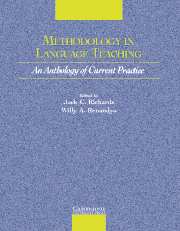Book contents
- Frontmatter
- Contents
- Acknowledgments
- Introduction
- Section I Approaches to Teaching
- Section 2 Lesson Planning and Classroom Management
- Section 3 Classroom Dynamics
- Section 4 Syllabus Design and Instructional Materials
- Section 5 Task and Project Work
- Section 6 Learning Strategies
- Section 7 Teaching Grammar
- Section 8 Teaching Pronunciation
- Section 9 Teaching Speaking
- Section 10 Teaching Listening
- Section 11 Teaching Vocabulary
- Section 12 Teaching Reading
- Section 13 Teaching Writing
- Chapter 29 Ten Steps in Planning a Writing Course and Training Teachers of Writing
- Chapter 30 The Writing Process and Process Writing
- Chapter 31 A Genre-Based Approach to Content Writing Instruction
- Chapter 32 Teaching Students to Self-Edit
- Section 14 Assessment
- Section 15 Technologies in the Classroom
- Section 16 Professional Development
- Credits
- Author Index
- Subject Index
- References
Chapter 32 - Teaching Students to Self-Edit
Published online by Cambridge University Press: 10 November 2010
- Frontmatter
- Contents
- Acknowledgments
- Introduction
- Section I Approaches to Teaching
- Section 2 Lesson Planning and Classroom Management
- Section 3 Classroom Dynamics
- Section 4 Syllabus Design and Instructional Materials
- Section 5 Task and Project Work
- Section 6 Learning Strategies
- Section 7 Teaching Grammar
- Section 8 Teaching Pronunciation
- Section 9 Teaching Speaking
- Section 10 Teaching Listening
- Section 11 Teaching Vocabulary
- Section 12 Teaching Reading
- Section 13 Teaching Writing
- Chapter 29 Ten Steps in Planning a Writing Course and Training Teachers of Writing
- Chapter 30 The Writing Process and Process Writing
- Chapter 31 A Genre-Based Approach to Content Writing Instruction
- Chapter 32 Teaching Students to Self-Edit
- Section 14 Assessment
- Section 15 Technologies in the Classroom
- Section 16 Professional Development
- Credits
- Author Index
- Subject Index
- References
Summary
INTRODUCTION
Over the past couple of decades, the process approach to teaching writing has greatly improved both L1 and L2 composition pedagogy. However, though students may be much better at invention, organization, and revision than they were before, too many written products are still riddled with grammatical and lexical inaccuracies. No matter how interesting or original a student's ideas are, an excess of sentence- and discourse-level errors may distract and frustrate instructors and other readers. Because this may lead to harsh evaluation of the student's overall writing abilities, ESL writing teachers, in addition to focusing on students' ideas, need to help students develop and improve their editing skills.
In the modern process approach composition classroom, editing refers to finding and correcting grammatical, lexical, and mechanical errors before submitting (or “publishing”) a final written product. A number of studies claim that a lack of grammatical accuracy in ESL student writing may impede students' progress in the university at large (Janopolous, 1992; Santos, 1988; Vann, Lorenz, & Meyer, 1991; Vann, Meyer, & Lorenz, 1984). As a university-level ESL writing teacher, I know the high standard of accuracy in student writing that the academic discourse community demands. My students will not succeed outside of the sheltered world of the ESL class unless they can learn to reduce their errors. Because I will not always be there to help my students, it is important that they learn to edit their own work.
- Type
- Chapter
- Information
- Methodology in Language TeachingAn Anthology of Current Practice, pp. 328 - 334Publisher: Cambridge University PressPrint publication year: 2002
References
- 4
- Cited by

